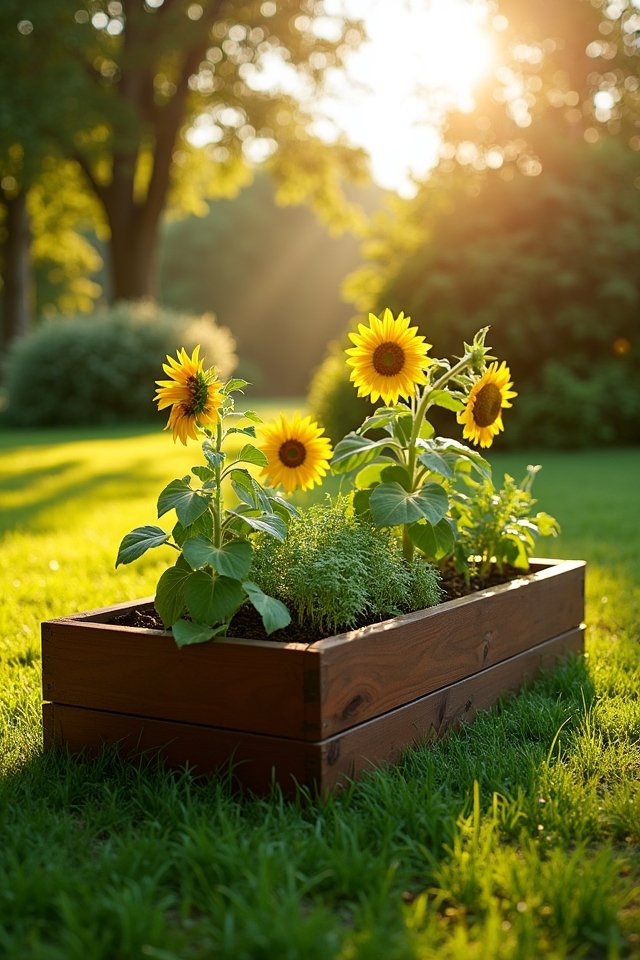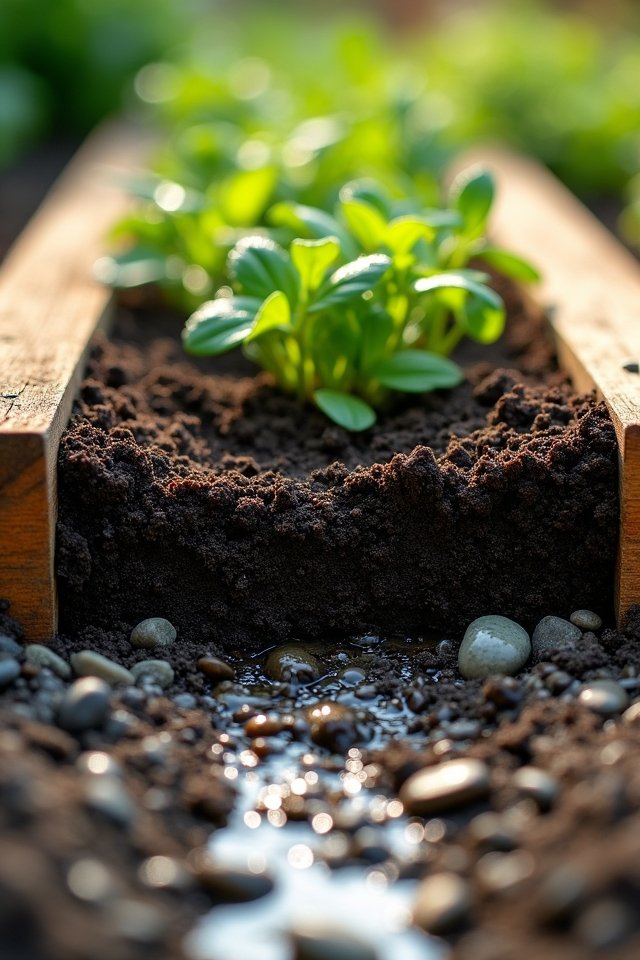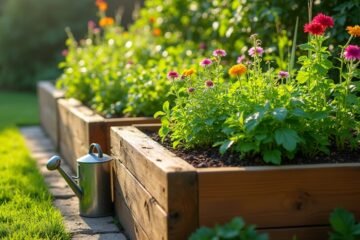Ready to make your gardening dreams come true? First, pick the perfect sunny spot—at least six hours of sunlight is a must! Then, choose durable materials like cedar to keep your bed looking sharp. Finally, don’t forget proper drainage! Adding gravel at the bottom prevents soggy roots, making sure your plants have room to breathe. Excited to grow your green oasis? Keep those gardening gloves handy because there’s plenty more to explore!
Choose the Right Location

Choosing the right location for your raised garden bed is like picking the perfect spot for a picnic—go for the sunniest, most cheerful patch of your yard! You’ll want at least six to eight hours of sunlight exposure daily to guarantee your plants flourish. Imagine them soaking up those golden rays like sunbathers at the beach! But don’t forget about wind protection, too. A breezy corner won’t be ideal; rather, look for a sheltered spot where those delicate seedlings can grow strong and vibrant. Think of a friendly tree, or a sturdy fence, hugging your garden bed like a protective blanket. With the right mix of warmth and security, you’re set to create a thriving green oasis that’ll make you proud!
Select Suitable Materials

Now that you’ve found the perfect sunny spot, it’s time to think about what materials to use for your raised garden bed! You’ve got some exciting wood options, like cedar or redwood, which not only look great but also resist rot like superheroes in the garden. If you’re feeling a bit edgy, don’t shy away from metal choices! Galvanized steel adds a modern flair, while still letting your plants bask in the glory of sunlight. Just imagine your veggies growing in stylish containers! Regardless of what you choose, make sure it’s durable and safe for your plants—what’s the point in growing a garden if it’s not healthy? Happy building, and let your creativity bloom!
Plan for Proper Drainage

While you might be enthusiastic to plunge into planting those beautiful blooms, a garden bed without proper drainage could lead to a soggy disaster! Nobody wants their plants swimming in muddy misery. So, let’s get creative with drainage solutions! Consider adding a layer of gravel at the bottom of your raised bed to promote water flow. Mixing in organic matter, like compost, improves soil composition, helping it retain just the right amount of moisture. You might also want to install perforated pipes, acting as little highways for excess water. Remember, healthy roots need breathing space too! With these fun ideas, you’ll guarantee your garden thrives, not dives! So, get ready to watch your plants bloom like never before in their well-drained paradise!
Frequently Asked Questions
What Vegetables Grow Best in Raised Garden Beds?
You’re in for a treat with raised garden beds! Let’s talk veggie selection! Carrots, beets, and lettuce thrive in this lush paradise. Pair them with companion plants like marigolds, which keep pesky bugs at bay. Imagine pulling fresh, crunchy carrots while a symphony of colors dances around you! Don’t forget about tomatoes and basil—they’re a match made in garden heaven! Why not plant something exciting this season? Your taste buds will thank you!
How Deep Should a Raised Garden Bed Be?
How deep should a raised garden bed be? Well, think of your vegetables’ roots as treasure hunters seeking rich, fertile soil! For ideal root growth, aim for a depth of at least 12 to 18 inches. This allows those adventurous roots to spread and thrive! If you’re planting carrots or tomatoes, a little extra depth goes a long way. Remember, happy roots equal bountiful harvests—so dig deep, and let the magic begin!
Can I Use Treated Wood for the Garden Bed?
You might be wondering if you can use treated wood for your garden bed, right? While treated wood can be durable, it often contains chemicals that can leach into the soil, raising garden safety concerns. Think about it—who wants veggies with a side of toxins? Instead, consider cedar or redwood! They’re naturally resistant to rot and bring that rustic charm. Your plants will thrive, and you can munch happily on your chemical-free harvest!
How Often Should I Water My Raised Garden Bed?
You should water your raised garden bed regularly, aiming for about 1 inch per week. Think of it as giving a drink to your thirsty plants! Use smart irrigation techniques, like drip systems, to target roots directly and boost moisture retention in the soil. Check the soil’s top inch—if it feels dry, it’s time to water! Remember, a happy plant is like a cheerful friend, thriving and full of life!
When Is the Best Time to Plant in Raised Beds?
The best time to plant in raised beds is during spring planting, right when the frost finally waves goodbye! Think of it as nature’s big warm hug. You’ll want to time your planting with the seasons, aiming for late March to early June. Imagine those vibrant tomatoes and lush herbs basking in the sun, ready to burst with flavor! Plan wisely, and enjoy a bountiful harvest—you won’t regret it! What are you waiting for?


